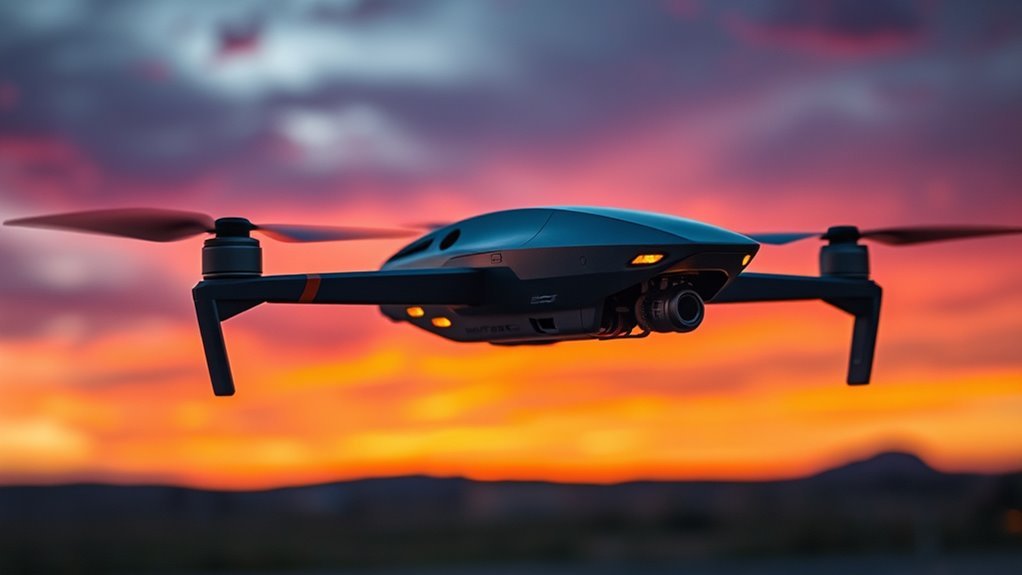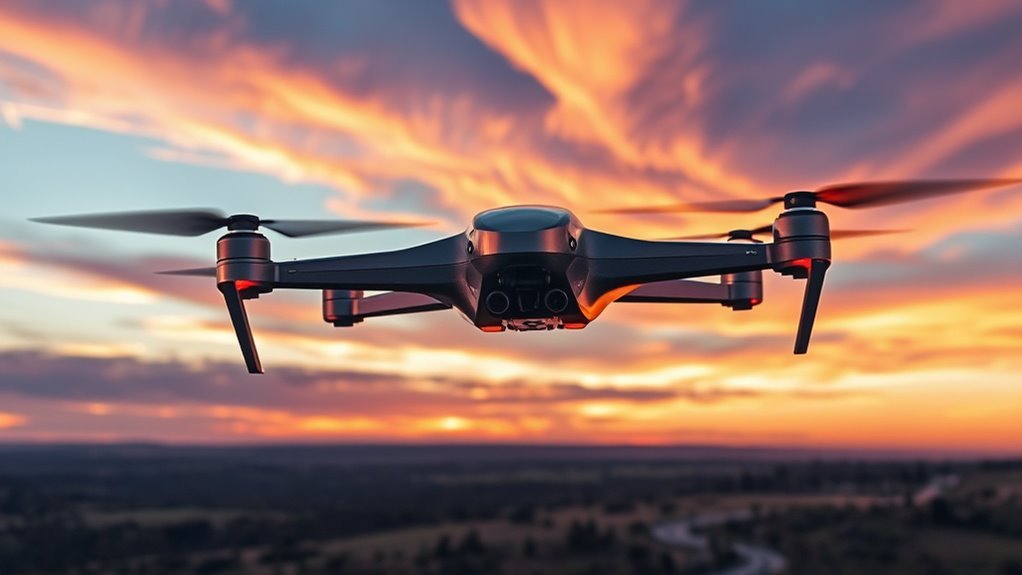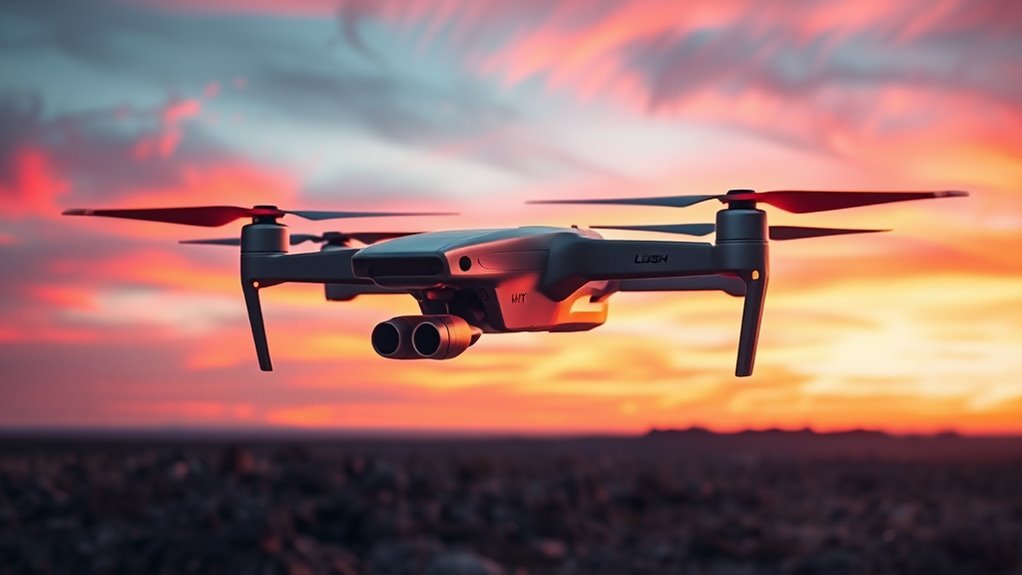An engine drone is a specialized unmanned aerial vehicle used for monitoring and inspecting aircraft engines. It employs advanced imaging technology, like high-resolution cameras and thermal sensors, to evaluate engine performance accurately. By integrating AI algorithms, these drones can detect anomalies and improve maintenance workflows. They offer real-time data feedback, enhancing safety while reducing costs. If you’re intrigued by the technological advancements and applications, there’s much more to discover about their impact.
Definition and Purpose of Engine Drones

Engine drones are specialized unmanned aerial vehicles designed primarily for monitoring and inspecting aircraft engines during maintenance and operational phases. These drones utilize advanced imaging technology to assess engine specifications, ensuring compliance with regulatory standards and operational integrity. You’ll find that their capabilities extend beyond simple visual inspections; they can collect data on engine performance, identify potential issues, and facilitate timely interventions. By integrating with existing maintenance systems, these drones enhance workflow efficiency and accuracy, providing real-time feedback that supports decision-making. With the ability to navigate challenging environments and gather critical information without human intervention, engine drones represent a significant advancement in aviation technology, granting you the freedom to operate with greater confidence and safety.
Key Features and Technologies

Several key features and technologies enable engine drones to excel in their monitoring and inspection roles. Advanced drone technology integrates high-resolution cameras and thermal imaging sensors, providing real-time data for precise analysis. These drones are often equipped with AI algorithms that enhance their ability to detect anomalies in engine design, ensuring efficient screening of potential issues. With robust propulsion systems, they can navigate complex environments, while their modular designs allow for easy upgrades and maintenance. Connectivity features such as 4G or 5G enable seamless data transmission, empowering operators to make informed decisions swiftly. Additionally, lightweight materials optimize flight efficiency, extending operational range. Together, these innovations create a powerful tool for enhancing engine integrity and performance assessment. Furthermore, the integration of advanced geofencing systems can improve operational safety by maintaining precise boundaries during inspections. The use of real-time data feedback also helps operators monitor and adjust operations based on immediate insights.
Applications in Aviation

In the domain of aviation, engine drones are revolutionizing maintenance and inspection protocols. These unmanned aerial vehicles streamline the inspection process, allowing technicians to assess engine performance with precision and efficiency. By utilizing advanced imaging and sensor technologies, you can identify issues before they escalate, greatly enhancing aviation safety. Compliance with engine drone regulations is essential, ensuring that operations adhere to established safety standards while maximizing the potential of drone technology. As you embrace these innovations, you’ll find that engine drones not only reduce downtime but also lower operational costs. The freedom to conduct thorough inspections in challenging environments empowers maintenance teams, ultimately leading to improved aircraft reliability and safety in the skies.
Applications in the Automotive Industry
In the automotive industry, engine drones are increasingly utilized for performance analysis and monitoring, providing real-time data on engine efficiency. Their capabilities extend to predictive maintenance solutions, allowing you to identify potential issues before they escalate. This proactive approach enhances vehicle reliability and optimizes maintenance schedules.
Performance Analysis and Monitoring
Engine drones play an essential role in performance analysis and monitoring within the automotive industry, providing valuable insights into vehicle efficiency and operational health. By utilizing advanced data analysis techniques, these drones gather real-time performance metrics that help you assess engine functionality and identify inefficiencies. You can analyze parameters like fuel consumption, temperature variations, and throttle response to optimize vehicle performance. This data not only enhances decision-making but also empowers you to calibrate systems for improved efficiency. With the ability to monitor several vehicles simultaneously, engine drones streamline the evaluation process, enabling you to make informed adjustments quickly. Ultimately, this technology fosters a more dynamic approach to automotive performance, granting you the freedom to enhance operational effectiveness.
Predictive Maintenance Solutions
Predictive maintenance solutions revolutionize the automotive industry by leveraging data from engine drones to anticipate potential failures before they occur. By utilizing predictive analytics, you can analyze real-time engine parameters, identifying patterns that may indicate wear or impending malfunctions. This proactive approach enables you to implement tailored maintenance strategies, reducing unexpected downtime and optimizing performance. Instead of following a fixed schedule, your maintenance can be data-driven, ensuring interventions are needed only when necessary. This not only enhances vehicle reliability but also maximizes resource efficiency, reducing costs. Engine drones provide a detailed view of engine health, empowering you to make informed decisions that promote operational freedom and flexibility in fleet management. Ultimately, predictive maintenance transforms how you manage automotive assets.
Benefits of Using Engine Drones
Using engine drones can markedly enhance efficiency and performance in your operations. They provide cost-effective maintenance solutions, reducing downtime and labor costs. Additionally, real-time data collection enables you to make informed decisions swiftly, optimizing overall productivity.
Enhanced Efficiency and Performance
While traditional methods of engine inspection and maintenance often rely on manual labor, the introduction of engine drones greatly enhances efficiency and performance. By leveraging advanced technology, you can achieve significant improvements in fuel efficiency and performance enhancement. Here are four key benefits:
- Precision Data Collection: Drones capture detailed engine data, reducing the margin for error.
- Speed of Inspection: They perform inspections in a fraction of the time, minimizing downtime.
- Enhanced Access: Drones reach hard-to-access areas, ensuring thorough assessments.
- Real-Time Monitoring: You can monitor engine conditions continuously, enabling proactive maintenance.
Integrating engine drones into your operations not only streamlines processes but also empowers you to maintain ideal engine performance with greater autonomy.
Cost-Effective Maintenance Solutions
Engine drones not only enhance efficiency but also provide considerable cost-effective maintenance solutions. By integrating these drones into your maintenance strategies, you can achieve substantial cost savings while improving overall operational effectiveness. Drones reduce the need for extensive manual inspections, which lowers labor costs and minimizes equipment downtime.
| Benefit | Traditional Methods | Engine Drones |
|---|---|---|
| Inspection Time | 4-6 hours | 30-60 minutes |
| Labor Costs | High | Considerably Lower |
| Equipment Downtime | Frequent | Minimal |
| Data Accuracy | Moderate | High |
| Safety Risks | High | Reduced |
Embracing engine drones not only liberates your resources but also empowers you to optimize maintenance strategies efficiently, paving the way for a more sustainable future.
Real-Time Data Collection
As maintenance operations evolve, the integration of drones into data collection processes offers significant advantages. By utilizing engine drones, you can enhance your data accuracy and streamline operations. Here are four key benefits:
- Real-time monitoring: Drones provide instant data, allowing for quicker decision-making.
- Advanced sensor integration: Equipped with various sensors, drones capture detailed insights into engine health.
- Increased safety: Drones can access hard-to-reach areas, minimizing risks for personnel.
- Cost efficiency: Reducing the need for extensive manual inspections saves time and resources.
Incorporating engine drones into your data collection strategy not only optimizes maintenance but also empowers you to make informed, timely decisions in a rapidly evolving landscape.
Challenges and Limitations
Although engine drones present innovative solutions for aviation and industrial applications, they also face significant challenges and limitations that must be addressed. Regulatory hurdles complicate the integration of drones into current airspace systems, often delaying deployment. Additionally, technical limitations, such as battery life and payload capacity, restrict operational efficiency. Furthermore, the complexities of airspace rights must be navigated to ensure safe operations in shared environments.
| Challenge | Description |
|---|---|
| Regulatory Hurdles | Compliance with aviation regulations can delay development and implementation. |
| Technical Limitations | Battery technology limits flight duration and payload capabilities. |
| Public Acceptance | Concerns regarding safety and privacy may hinder widespread adoption. |
To harness the full potential of engine drones, innovators must overcome these barriers, ensuring reliable and efficient operation in various sectors. Furthermore, understanding signal attenuation is critical for optimizing drone performance in complex environments.
The Future of Engine Drone Technology
While many challenges currently impede the advancement of engine drone technology, the future holds promising developments that could revolutionize various industries. You can expect future innovations driven by:
- Enhanced Efficiency: Improved designs will optimize fuel consumption and performance.
- Autonomous Systems: Advances in AI will enable fully automated operations, reducing human intervention.
- Flight Safety: Innovative safety protocols and redundant systems will enhance reliability and public confidence.
- Regulatory Considerations: As regulations evolve, clearer guidelines will facilitate smoother integration into commercial airspace.
These advancements not only promise to enhance operational capabilities but also empower industries to explore new opportunities. Additionally, the integration of advanced AI in engine drones could further streamline operations and improve safety measures. Embracing these changes will ultimately pave the way for a freer, more dynamic use of engine drones across various sectors.
Frequently Asked Questions
How Do Engine Drones Communicate With Other Systems?
Think of a symphony; engine drones communicate using signal protocols to harmonize with other systems. Through precise data transmission, they guarantee seamless integration, allowing for efficient operation and enhanced performance in complex environments.
What Is the Average Lifespan of an Engine Drone?
The average lifespan of an engine drone typically ranges from 5 to 10 years, depending on advances in engine technology and maintenance practices. Regular inspections and updates can greatly extend their operational longevity and efficiency.
Are Engine Drones Safe to Use in Crowded Areas?
Imagine a tightrope walker balancing high above a crowd. Engine drone safety in crowded areas requires strict precautions. Proper planning, operator training, and adherence to regulations guarantee safe operation, minimizing risks while maximizing freedom for all involved.
How Are Engine Drones Maintained and Serviced?
To guarantee peak performance, you’ll need regular engine drone maintenance, including inspection of components, software updates, and battery checks. Engine drone servicing involves thorough diagnostics, repairs, and adherence to safety protocols for reliable operation.
What Regulations Govern the Use of Engine Drones?
You’ll need to adhere to strict regulatory compliance and operational guidelines when using engine drones. These regulations guarantee safety, efficiency, and freedom in operation, allowing you to maximize their potential while minimizing risks and legal issues.

